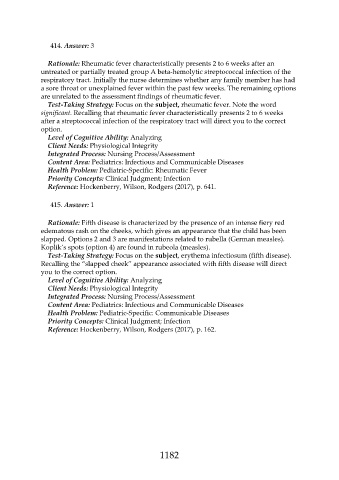Page 1182 - Saunders Comprehensive Review For NCLEX-RN
P. 1182
414. Answer: 3
Rationale: Rheumatic fever characteristically presents 2 to 6 weeks after an
untreated or partially treated group A beta-hemolytic streptococcal infection of the
respiratory tract. Initially the nurse determines whether any family member has had
a sore throat or unexplained fever within the past few weeks. The remaining options
are unrelated to the assessment findings of rheumatic fever.
Test-Taking Strategy: Focus on the subject, rheumatic fever. Note the word
significant. Recalling that rheumatic fever characteristically presents 2 to 6 weeks
after a streptococcal infection of the respiratory tract will direct you to the correct
option.
Level of Cognitive Ability: Analyzing
Client Needs: Physiological Integrity
Integrated Process: Nursing Process/Assessment
Content Area: Pediatrics: Infectious and Communicable Diseases
Health Problem: Pediatric-Specific: Rheumatic Fever
Priority Concepts: Clinical Judgment; Infection
Reference: Hockenberry, Wilson, Rodgers (2017), p. 641.
415. Answer: 1
Rationale: Fifth disease is characterized by the presence of an intense fiery red
edematous rash on the cheeks, which gives an appearance that the child has been
slapped. Options 2 and 3 are manifestations related to rubella (German measles).
Koplik’s spots (option 4) are found in rubeola (measles).
Test-Taking Strategy: Focus on the subject, erythema infectiosum (fifth disease).
Recalling the “slapped cheek” appearance associated with fifth disease will direct
you to the correct option.
Level of Cognitive Ability: Analyzing
Client Needs: Physiological Integrity
Integrated Process: Nursing Process/Assessment
Content Area: Pediatrics: Infectious and Communicable Diseases
Health Problem: Pediatric-Specific: Communicable Diseases
Priority Concepts: Clinical Judgment; Infection
Reference: Hockenberry, Wilson, Rodgers (2017), p. 162.
1182

